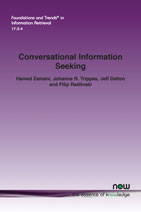Conversational Information Seeking
By Hamed Zamani, University of Massachusetts Amherst, USA, zamani@cs.umass.edu | Johanne R. Trippas, RMIT University, Australia, j.trippas@rmit.edu.au | Jeff Dalton, University of Edinburgh, UK, jeff.dalton@ed.ac.uk | Filip Radlinski, Google Research, UK, filiprad@google.com
Abstract
Conversational information seeking (CIS) is concerned with a sequence of interactions between one or more users and an information system. Interactions in CIS are primarily based on natural language dialogue, while they may include other types of interactions, such as click, touch, and body gestures. This monograph provides a thorough overview of CIS definitions, applications, interactions, interfaces, design, implementation, and evaluation. This monograph views CIS applications as including conversational search, conversational question answering, and conversational recommendation. Our aim is to provide an overview of past research related to CIS, introduce the current state-of-the-art in CIS, highlight the challenges still being faced in the community, and suggest future directions.
Conversational Information Seeking
Over the years, information retrieval and search systems have become more conversational. The last few years have seen a tremendous acceleration of this evolution driven by progress in machine learning. Whereas the possibility of a conversational information seeking (CIS) system robustly understanding conversational input from a person was previously limited, it can now almost be taken for granted. Consumer hardware that supports and encourages conversation is now common, raising awareness of — and the expectation of — conversational support in information retrieval systems. From the research community, this has been accompanied by significant progress in defining more natural CIS tasks, metrics, challenges, and benchmarks. As these developments allowed the field to expand rapidly, this monograph aims to summarize the current state-of-the-art of CIS research, and provide an introduction to new researchers as well as a reference for established researchers in this area.
This monograph provides a thorough overview of CIS definitions, applications, interactions, interfaces, design, implementation, and evaluation. The authors view CIS applications as including conversational search, conversational question answering, and conversational recommendation. Their aim is to provide an overview of past research related to CIS, introduce the current state-of-the-art in CIS, highlight the challenges still being faced in the community, and suggest future directions.
